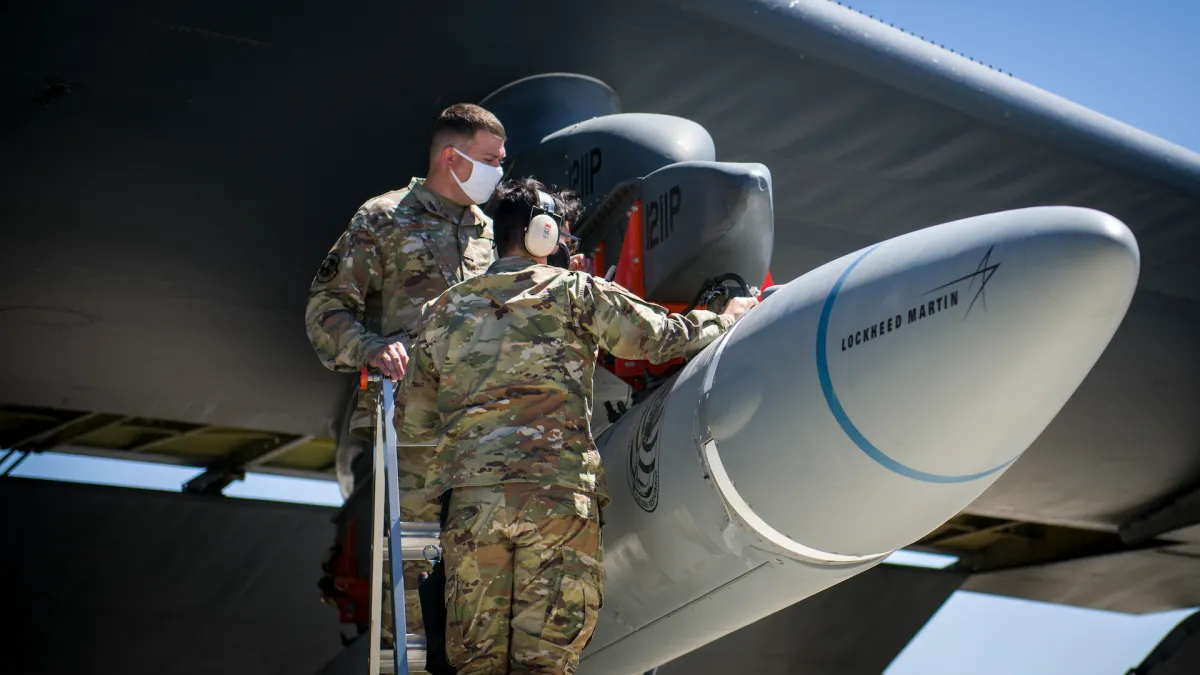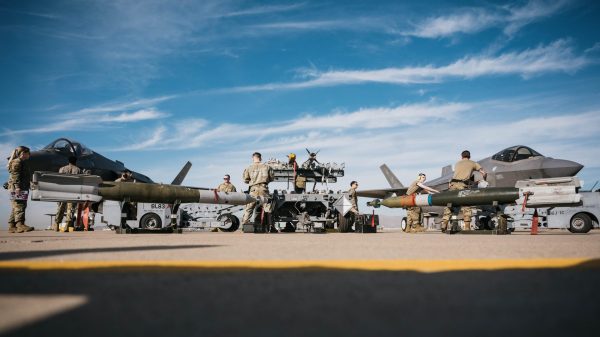Air Force has ‘concerns’ about HACM; hasn’t ruled out boost-glide hypersonic weapons

The Air Force’s Hypersonic Attack Cruise Missile (HACM) program faces challenges that must be addressed. Meanwhile, the service hasn’t written off the possibility of acquiring boost-glide systems despite hiccups with the Air-Launched Rapid Response Weapon (ARRW), according to its top weapons buyer.
The Pentagon has been pursuing multiple types of hypersonics that have unique characteristics. Boost-glide missiles such as ARRW are first launched from a rocket booster that gives them sufficient energy to reach speeds greater than Mach 5 and then glide toward their targets. In contrast, hypersonic cruise missiles use air-breathing engines known as scramjets.
Last year, Raytheon was tapped to be the prime contractor for the HACM project.
“It is early days in the program, and so you certainly hope that a program like HACM is on track at this stage, because it’s quite early. And they typically are, right? And so, I’d say it’s on track but it is a challenging program. That’s why we’re undertaking a rapid prototyping effort really is to work through some of the potential risks, some of the potential technical risks associated with the HACM concept,” Assistant Secretary of the Air Force for Acquisition, Technology and Logistics Andrew Hunter told DefenseScoop in an interview Tuesday.
“Of course, we’ve been building off of work that was previously done by the department in that program, so that has provided a great foundation for it. And then the Air Force effort is to turn that into something that’s more operationally useful. So, I do think there are concerns, as there are with any hypersonic technology, that we have to wring through how these work operationally and make sure that our test capabilities are sufficient to really help us know that we have a meaningful military capability,” he added.
Hypersonics are a top modernization priority for the Air Force as well as the Army and Navy. U.S. adversaries, including Russia and China, are also pursuing these types of systems, which are designed to fly faster than Mach 5, be highly maneuverable, and take unpredictable flight paths. Those characteristics make them difficult to track and intercept.
For the Air Force, hypersonic cruise missiles offer advantages over boost-glide systems in that they are smaller and can fit on fighter jets, not just large bombers like the B-52 that’s been used to test the ARRW. However, some experts say they are more complex to develop.
The ARRW effort was dealt a blow after a March test was deemed unsuccessful. There have been at least two tests since then, including one in August and another in October, but the Air Force has provided few details about how well they performed.
“The rapid prototyping program is continuing. It’s been accomplishing flight tests, which has definitely been adding to our capabilities in the hypersonic realm. It adds to our understanding of … the capabilities that industry can provide, as it has provided under ARRW. And also adds to our ability to do test of hypersonic capabilities, which is really actually quite a key thing because the nature of hypersonic systems is they create a demand signal for a lot of new test capabilities, which we’ve been able to demonstrate with ARRW. And there will be more testing on ARRW in ‘24. So that effort does continue for the rapid prototyping program and testing,” Hunter told DefenseScoop.
Lockheed Martin is the prime contractor for ARRW.
Air Force Secretary Frank Kendall said earlier this year that the service was more committed to HACM. DefenseScoop asked Hunter if the Air Force had decided to abandon the idea of acquiring a boost-glide system for the foreseeable future and focus on the cruise missile effort.
“There are different approaches to delivering hypersonic capability. And we have not ruled out any of those approaches for the Air Force in the future,” he said.
More information about the fate of the ARRW effort and the service’s plans for advanced weapons will be revealed when the service releases its fiscal 2025 budget request early next year. During the interview, Hunter didn’t disclose whether additional funding will be included for ARRW or follow-on work in the next budget submission.
Meanwhile, Hunter declined to say when the service anticipates HACM will be fielded or the projected cost per round. Broadly, Undersecretary of Defense for Acquisition and Sustainment Bill LaPlante has said the Pentagon should aim for an average procurement unit cost in “the single digit millions” for its hypersonic missiles.
“We’re actually looking at some that are as low as $3 million an all-up round. That’s where we want to be,” he said at a conference in April.
Hunter told DefenseScoop that the Air Force has a cost target in mind for HACM, but he was tight-lipped about it.
“We do set targets for all of our programs and I’m a big believer in them. [But] I’m not gonna tell you what the target is,” he said.
The cost per round will affect decisions about how many missiles the Air Force should buy.
“As you look at the munitions portfolio — and let me just kind of speak generally about hypersonics versus, you know, the rest of the munitions, of which there’s a huge variety … it’s definitely a mix, right?” Hunter said. “We need affordable mass for munitions just like we need affordable mass for platforms. And that’s something that we’re working very hard on. And then you need the high-end things, right, that can go into the most contested environments and address the … highest priority threats.”
He continued: “And generally speaking, hypersonic capability tends to go in the highest threat conditions and go after the highest priority threats. And it’s optimized for that. And part of that is the cost equation, and part of it is that the capability that it provides allows it to do that, right? And those two are related facts.”
Because of their relatively high price tag and the types of targets they’re intended for, hypersonics will likely be “fewer in number” than some of the common types of munitions in the Air Force’s arsenal, he suggested.






